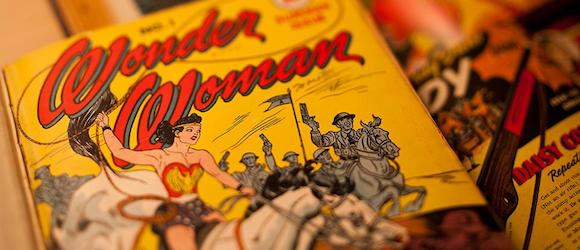There’s only one comic book on the Smithsonian Magazine’s feature “101 Objects That Made America,” and it’s Wonder Woman #1.
The challenge of any museum is to figure out how to present its holdings to its audience, in a word, the challenge of curation. The folks at Smithsonian Mag point out, rightfully, I think, that there’s curating a museum, and then there’s trying to figure out how best to present the 137 million artifacts of American history in their possession in an interesting and comprehensive way. Their latest in what hopefully will be a neverending series of attempts to share their goodies with the world is the “101 Objects That Made America.”
The selection is separated into nine subjects, including Freedom, Invention, Discovery, and Wild America. Nestled in the Power section, alongside Abraham Lincoln’s top hat, Susan B. Anthony’s gavel, and a Greensboro lunch counter, are photos of an issue of Wonder Woman #1.
“Not even girls want to be girls so long as our feminine archetype lacks force, strength and power,” psychologist William Moulton Marston wrote in 1943. He had already modeled a new archetype on his wife and fellow psychologist, Elizabeth Holloway Marston, and Olive Byrne, a homemaker who lived with the Marstons in a relationship that included shared children. Wonder Woman, a magic-lasso-toting dispenser of justice, broke the superhero glass ceiling in All Star Comics in December 1941.
Reads the explanatory blurb below. Superhero comics are often listed alongside Jazz as a quintessentially American art form, and so I find myself getting just a touch emotional over the choice of Wonder Woman to represent them rather than Action Comics #1. Then again, she’s only member of the Justice League that wears an American flag colored costume. According to Tim Hanley on his Wonder Woman blog, unlike some folks I can think of, the Smithsonian has a history of paying attention to and preserving artifacts of the Amazonian Princess’ place in American history.
The Smithsonian has an excellent Wonder Woman collection, particularly in terms of the Golden Age, and I’ve been lucky enough to see a lot of it. There are great letters between William Moulton Marston and his publisher, M.C. Gaines; notes for Wonder Woman issues; an assortment of Marston’s articles; and many other odd and interesting things. The Smithsonian is a fantastic resource for researching Wonder Woman, and a lot of the items have been digitized so you can get access to them (after filling in the proper forms) without actually having to travel to the Smithsonian itself. I highly recommend checking it out.
You can see all 101 objects online here, in an upcoming book, and in a series on the Smithsonian Channel starting on November 25th.
(The Smithsonian Magazine via Straightened Circumstances.)









Published: Oct 30, 2013 11:04 am